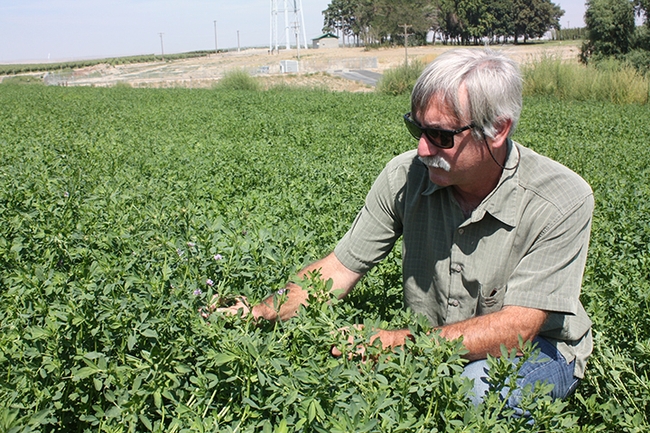- Author: Kathy Keatley Garvey
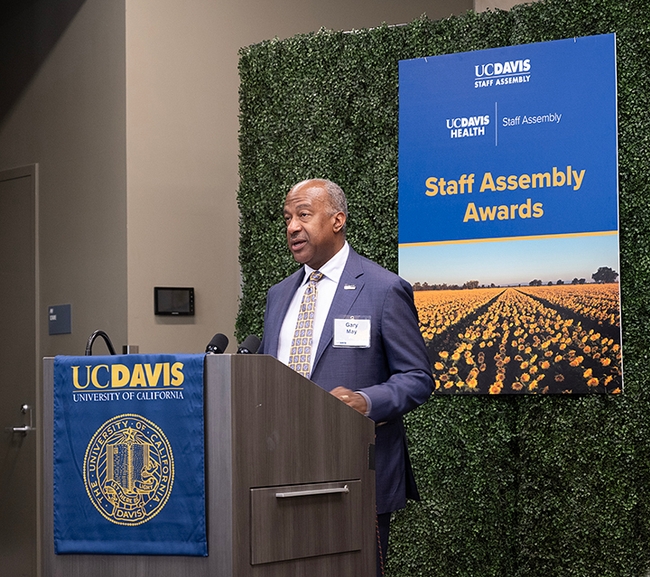
For "outstanding achievements and notable contributions in disseminating science-based beekeeping information since 2016,” the UC Davis-based California Master Beekeeper Program (CAMBP) won a 2023 UC Davis Staff Assembly “Citation of Excellence” and praise from Chancellor Gary May.
CAMBP director and founder Elina Lastro Niño, associate professor of Cooperative Extension and a member of UC Davis Department of Entomology and Nematology faculty, and co-program manager Wendy Mather share the Faculty-Staff Partnership Award.
Niño, UC Extension apiculturist since 2014, founded CAMBP in 2016. Mather joined the program in March of 2018. Also integral to the program is Kian Nikzad, but as a newer employee, was ineligible to be nominated.
The awards ceremony, held Sept. 12 in the International Center on campus, singled out “some of our most exceptional UC Davis individuals and teams,” Chancellor May said in his presentation.
Nikzad accepted the award on behalf of Niño, who was participating in Apimondia in Santiago, Chile, conferring with colleagues at the UC Davis Chile Life Sciences Innovation Center, a part of UC Davis Global Affairs. She was assisting them in developing a sustainable and environmentally friendly science-based beekeeping program to support the success of farmers and beekeepers at all economic levels.
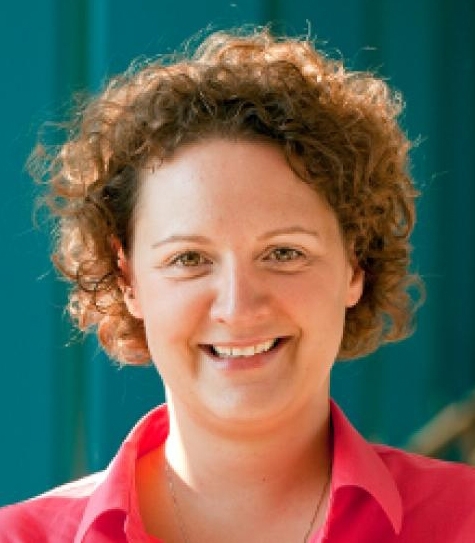
“I truly appreciate everything you do on a daily basis to make UC Davis a wonderful place,” the chancellor said. “You are the heart of UC Davis and I'm grateful for your dedication and hard work...you “contribute to our university's success and make UC Davis a more enjoyable, creative, inclusive and invigorating place to work.”
Nomination. Nominators of "The Bee Team" lauded Niño and Mather for providing a “program of learning, teaching, research, and public service, goes above and beyond in delivering comprehensive, science-based information about honey bees and honey bee health. They continually and consistently develop, improve, and refine their statewide curriculum that educates stewards in a train-the-trainer program to disseminate accurate, timely, and crucial information. Honey bees pollinate more than 30 California crops, including almonds, a $5 billion industry (no bees, no pollination, no almonds). Indeed, California produces more than a third of our country's vegetables and three-quarters of our fruits and nuts. However, colony losses are alarming due to pesticides, pests, predators and pathogens.”
As of Sept. 15, 2023, CAMBP has donated 34,000 hours of volunteer time and served 209,000 individuals in education, outreach and beekeeping mentorship. If a volunteer hour were to be calculated at $26.87, CAMBP has given $913,580 back to California in service of science-based beekeeping and honey bee health.
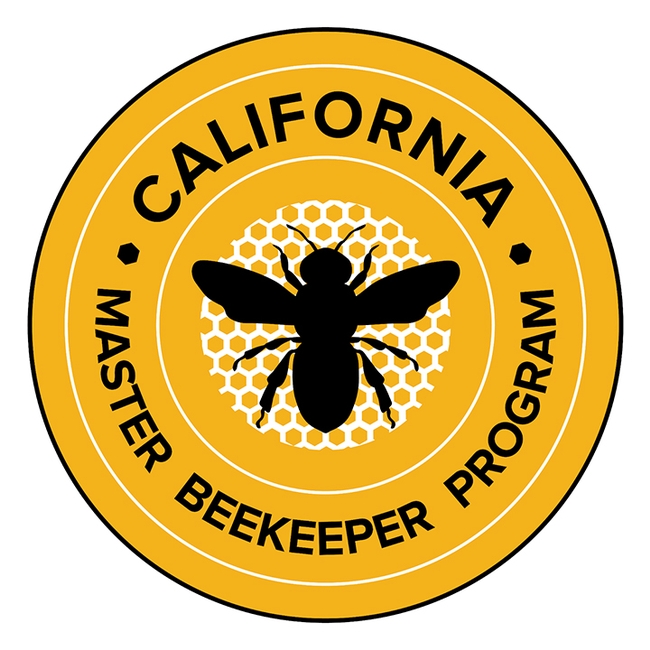
Scholarships. “No money?” wrote the nominators (Kathy Keatley Garvey, Nora Orozco and Tabatha Yang from the Department of Entomology and Nematology). “No problem. (CAMBP) has donated 12 scholarships, worth $250 each; helped novices who can't afford mentoring or equipment by linking them with veteran beekeepers; and is engaging in free bee removals--rescuing and relocating bees.”
Over the past year, CAMBP has developed and expanded its educational materials. This includes launching an asynchronous online course and in-person preparatory programs with its partners. It is updating safety materials and developing an Epinephrine auto-injector/CPR course, geared toward “everyone from 4-H beekeepers to novice beekeepers to the general public,” the nominators wrote.
CAMBP also teaches “schoolchildren about bees at specially guided garden tours at UC Davis, inspiring them “to care for the bees and plant nectar and pollen resources.”
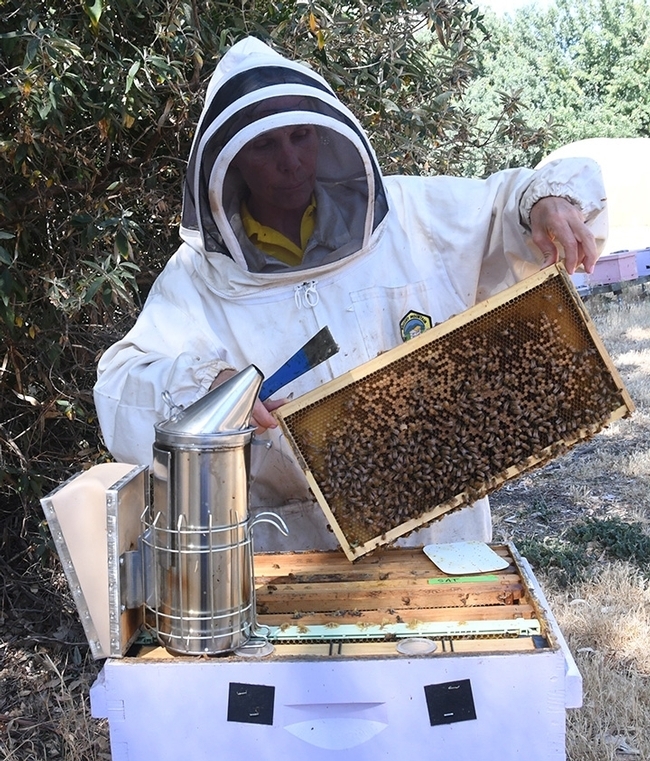
Its website, accessible to the public, offers a list of classes and knowledge-based information, including backyard beekeeping, bees in the neighborhood, bees and beekeeping regulations, defensive bees, live honey bee removals, and protecting pollinators.
“Bottom line,” the nominators concluded, “our ‘B' Team is really an ‘A' Team, an outstanding example of UC Davis teaching, research and service; a team providing exemplary service and contributions; and a team that creates and maintains high morale and embodies the Principles of Community.”
Joint Statement. In a joint statement following the awards ceremony, Mather and Nikzad said: “We share this award with our passionate and caring member volunteers. Our members are deeply committed to honey bee health, science-based beekeeping practices, and, most importantly, to each other. Their enthusiasm and dedication drive our mission forward. We wish to acknowledge Elina Niño for her visionary leadership; she has brought together various stakeholders, including growers, bee breeders, commercial, sideline, and hobbyist beekeepers, as well as the general public, through CAMBP, UC Davis, UC Agriculture and Natural Resources (UC ANR) and UC Cooperative Extension (UCCE). We missed having her at the ceremony.”
At the Staff Assembly ceremony, one other team received a Faculty-Staff Partnership Award Excellence Award: the Graduate Mentoring Initiative, comprised of Ambarish Kulkarni, faculty, Department of Chemical Engineering; Pamela Lein, faculty, Department of Molecular Bioscience; and Elizabeth Sturdy, staff, director of the Mentoring and Academic Success Initiative, Graduate Studies.
Serving as co-chairs of the 2023 Citations of Excellence Committee were Darolyn Striley, manager of the Office of Student Development, School of Medicine, and Mary Carrillo, business operations manager, Languages and Literatures.
Staff Assembly sponsors the annual Citations of Excellence awards program to provide recognition for UC Davis and UC Davis Health individual staff and staff teams “who have demonstrated outstanding achievement in one of the following areas: teaching, research, service, innovation, supervision, mentorship, team awards and faculty/staff partnership award.”
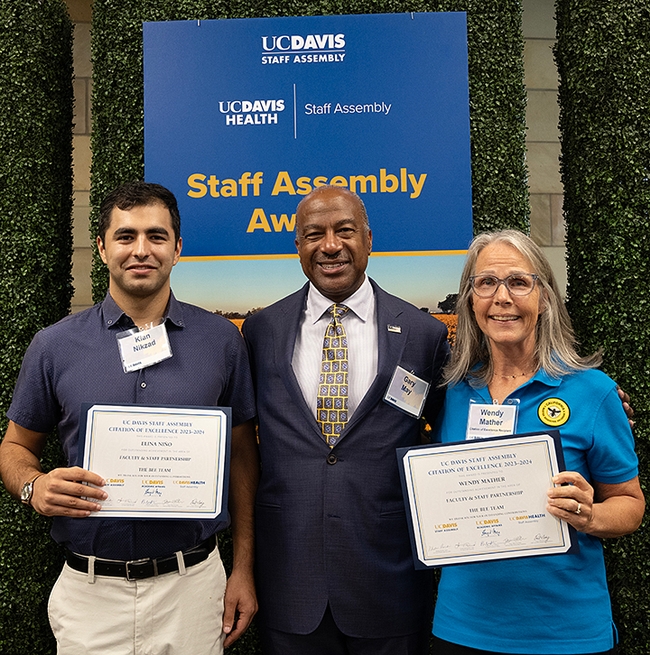
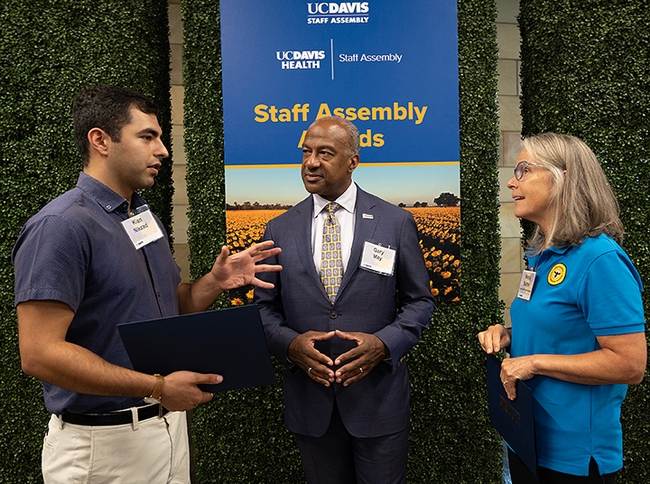
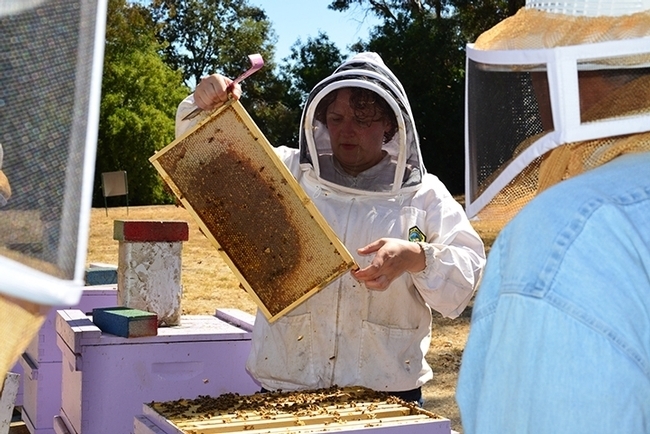
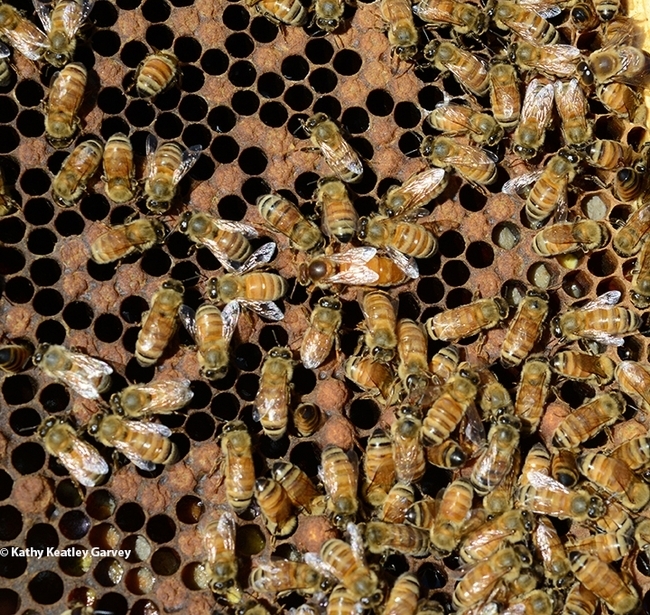
- Author: Kathy Keatley Garvey
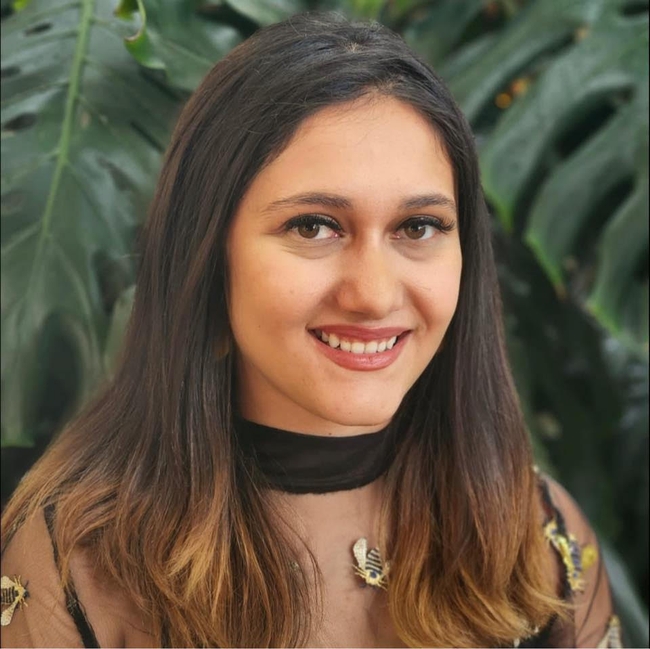
The event, free and family friendly, will take place in Room 1124 of the Academic Surge Building, 455 Crocker Lane, UC Davis. Parking is also free.
Among the presenters will be
- Lynn and Bob Kimsey of the UC Davis Department of Entomology and Nematology faculty. Lynn, a hymenopterist, is a UC Davis distinguished professor who teaches general entomology and the biodiversity of California insects and serves as the director of the Bohart Museum, and Bob is a forensic entomologist, specializing in public health entomology; arthropods of medical importance; zoonotic disease; biology and ecology of tick-borne pathogens; tick feeding behavior and biochemistry.
- Carla-Cristina "CC" Melo Edwards, a first-year doctoral student in the laboratory of medical entomologist-geneticist Geoffrey Attardo, associate professor of entomology, UC Davis Department of Entomology and Nematology. She will share her expertise on mosquitoes and show specimens.
- Moriah Garrison, senior entomologist and research coordinator with Carroll-Loye Biological Research (CLBR). She is scheduled to show live ticks and mosquitoes and field questions.
- Educators from the Sacramento-Yolo Mosquito and Vector Control District. They will discuss mosquitoes and their program
- Nazzy Pakpour, UC Davis alumna, Novozymes scientist and author of Please Don't Bite Me
- Jeff Smith, curator of the Bohart Museum's ;Lepidoptera (butterflies and moths) collection. He will display butterfly specimens collected globally. Also on the "Lep crew" are Bohart volunteers Greg Kareofelas and Brittany Kohler.
CC Edwards. In the Attardo lab, CC focuses her research "on investigating the physiological mechanisms underlying pyrethroid resistance in Aedes aegypti (the yellow fever mosquito)." She was a McNair scholar at Baylor University, where she completed her undergraduate degree in cell and molecular biology in May 2021. "I got interested in the mosquito field through my undergraduate research of studying the sensory and oviposition responses of Aedes aegypti in relation to the compound geosmin."
"I went on to do my masters at Texas Tech University under the advisement of Dr. Corey Brelsfoard where I graduated this past summer (2023)," she said. "I investigated the effects of microplastics in relation to the mosquitoes Aedes aegypti and Aedes albopictus (the Asian tiger mosquito). Plastic pollution has been a worldwide problem and research has shown that microplastics have been found in the guts of various organisms. With Aedes species being container inhabiting species, my master's research was focused on investigating if there are alterations of the mosquitoes' microbiomes and their immunity due to the ingestion of microplastics."
"When I am not in the lab, I enjoy getting involved with my local community by helping out and doing outreach," Edwards said. This past summer she helped the city of Lubbock, Amarillo, and the Texas Public Health Department by identifying mosquitoes for West Nile surveillance. She also served as the outreach chair for the Texas Tech Association of Biologists during her masters' degree pursuit and enjoyed being a mentor for first-generation students.
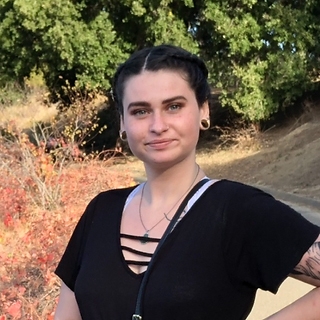
CLBR, involved in insect repellent testing and natural product development, is owned and managed by scientists Scott Carroll and Jenella Loye, a husband-wife team affiliated with UC Davis Department of Entomology an Nematology. Formed in 1989, the company serves the consumer products industry with testing, development and regulatory services for insect repellents, organic products, and low toxicity pesticides. Carroll, president of CLBR, is an evolutionary biologist, while Loye is a medical entomologist and microbiologist. Carroll holds a doctorate in biology/biological sciences from the University of Utah, while Loye holds a doctorate in zoology, microbiology and epidemiology from the University of Oklahoma.
Photography Displays. Professor Attardo, who maintains a lab website on Vector Biology and Reproductive Biology at http://attardo-lab.com, and chairs the Designated Emphasis in the Biology of Vector-Borne Diseases (DEBVBD), will display some of his mosquito images, including a blood-fed Aedes aegypti, and a female and male Culex tarsalis. Alex Wild, a UC Davis doctoral alumnus and curator of entomology, University of Texas, Austin, will display an image of mosquito larvae that currently hangs in Briggs Hall, home of the UC Davis Department of Entomology and Nematology. Wild's insect images can be viewed on his website, https://www.alexanderwild.com.
Petting Zoo. A popular attraction is the live petting zoo; visitors are encouraged to hold or get acquainted with live Madagascar hissing cockroaches and stick insects.
Family Arts and Crafts Activity. The event will be held outside and will highlight two collecting techniques, said Tabatha Yang, education and outreach coordinator.
- Clear Packing Tape Art. "Clear packing tape is a good way to collect small, hard-to-see insects," Yang said. "Glitter will mimic small insects like fleas or bed bugs. Putting the tape on white paper makes it easy to look at them under a microscope and for this craft it will make a pretty card."
- Making insect collecting or "kill" jars. Participants are asked to bring a recycled jar. "This should be a clean and dried glass jar with a wide, metal top--think jam, pickle, peanut butter jars. Four to 16-ounce jars work well. We will have some on hand as well, but recycling is good! We will fill the bottom with plaster of paris and let it dry and teach people how to use it properly, using something like nail polisher remover containing ethyl acetate as the killing agent. A UC Davis Department of Entomology and Nematology video explains the procedure: https://youtu.be/s8yCzFGzbn8?si=71sNmA5l8NyP1zj0
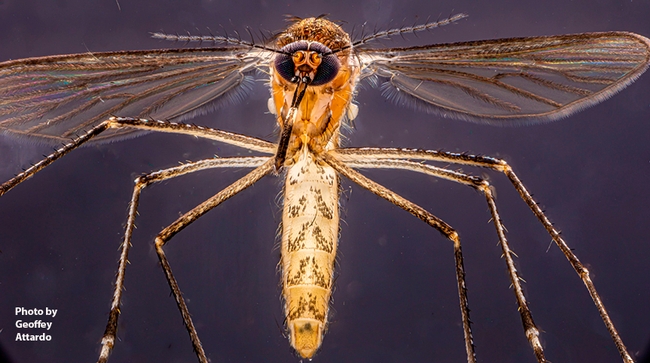
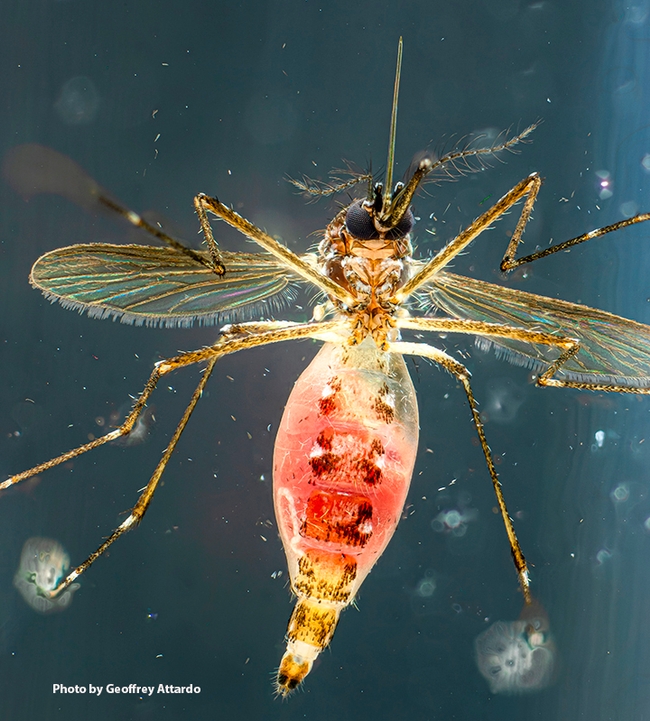
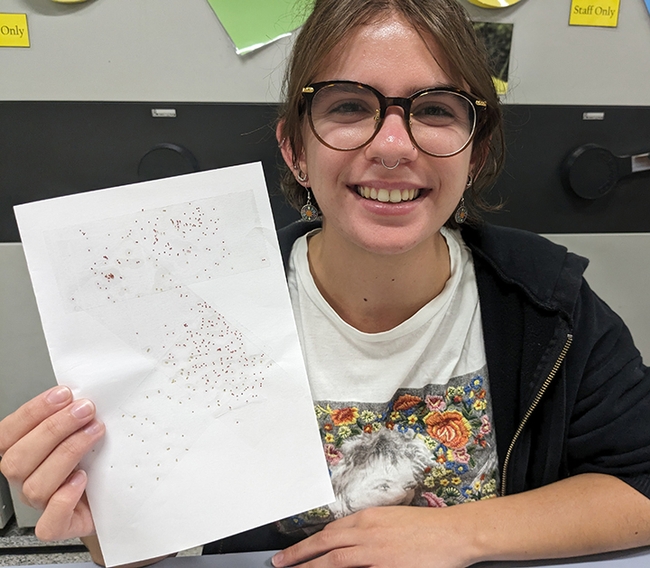
- Author: Kathy Keatley Garvey

Noted entomologist and UC Davis doctoral alumnus Michael Hoffmann, an emeritus professor at Cornell University known for his advocacy of climate change literacy and the relationship between food and climate change, plus his leadership activities and biological control projects, will deliver the Thomas and Nina Leigh Distinguished Alumni Award Seminar on Monday, Oct. 9 in the Student Community Center, UC Davis.
The Leigh seminar, hosted by the UC Davis Department of Entomology and Nematology, annually honors distinguished alumni. Hoffmann was selected the 2020 recipient, but the COVID pandemic intervened. This is first seminar since the beginning of COVID pandemic.
Hoffmann will present his lecture from 4 to 5 p.m., in Room D, second floor of the Student Community Center. It is free and open to the public and no reservations are required.
An invitational reception and buffet dinner will follow in the Student Community Center.
Hoffmann, who received his doctorate in entomology in 1990 from UC Davis, studying with Professor Ted Wilson and later Professor Frank Zalom, will present the seminar on “Our Changing Menu--Climate Change and the Foods We Love and Need,” the title of a book he co-authored with Carrie Koplinka-Loehr, and Danielle Eiseman in April, 2021.

The co-authors "offer an eye-opening journey through a complete menu of before-dinner drinks and salads; main courses and sides; and coffee and dessert. Along the way they examine the escalating changes occurring to the flavors of spices and teas, the yields of wheat, the vitamins in rice, and the price of vanilla." They round out their story "with a primer on the global food system, the causes and impacts of climate change, and what we can all do. Our Changing Menu is a celebration of food and a call to action?encouraging readers to join with others from the common ground of food to help tackle the greatest challenge of our time."
Hoffmann transitioned to emeritus in January 2020 after 30 years at Cornell, but remains active. Serving as executive director of the Cornell Institute for Climate Smart Solutions (2015-2020), he continues to provides visionary leadership, communicates to a wide range of audiences the challenges and opportunities that come with a changing climate, and builds partnerships among public and private organizations.
Hoffmann's leadership activities include co-chairing the President's Sustainable Campus Committee and helping to lead a climate change literacy initiative for students, staff, and faculty. He dedicates his time toward what he calls “the grand challenge of climate change and (to) help people understand and appreciate what is happening through food.” Effectively communicating about climate change, Hoffmann presented a TEDX talk in 2014 on “Climate Change: It's Time to Raise Our Voices” that drew widespread attention.
A native of Wisconsin, Hoffmann holds a bachelor of science degree (1975) from the University of Wisconsin, and his master's degree from the University of Arizona (1978). He served with the U.S. Marines in Vietnam from 1967 to 1971, achieving the rank of sergeant.
UC Davis Experiences. Hoffmann remembers well his experiences at UC Davis. “I was privileged to work with many dedicated faculty in entomology and several other departments.”
After receiving his doctorate at UC Davis, Hoffmann joined the faculty of Cornell in 1990 as an assistant professor, with 60 percent Extension and 40 percent research duties, and advanced to associate professor in 1996, and professor in 2003. His academic career focused on administrative endeavors (80 percent) beginning in 1999.
Hoffmann's career at Cornell included serving as associate dean of the College of Agriculture and Life Sciences, associate director of Cornell Cooperative Extension, director of the Cornell University Agricultural Experiment Station, and director of the New York State Integrated Pest Management Program. He helped initiate a leadership and professional development week-long program that benefited more than 400 faculty at Cornell and beyond.
Prior to his administrative duties, he worked to develop and implement cost-effective and environmentally sensitive tactics for management of insect pests. He emphasized biological control, development and application of insect behavior modifying chemicals, and novel control tactics, all in an integrated pest management (IPM) context. Much of his research and Extension programming was multi-state and multidisciplinary in nature.
Among his entomological achievements, he
- Developed unique, cost-effective and environmentally benign biological control tactics for insect pest of sweet corn, peppers and potatoes, and presented wide scale demonstrations on conventional and organic farms in New York, Virginia, Massachusetts and Canada.
- Published the first popular guide to beneficial insects (64 pages, with more than 5,000 copies distributed)
- Developed patented unique fiber barrier technology for pest control
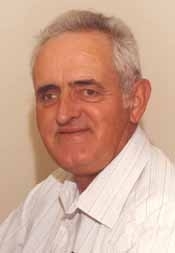
His publication record includes 105 refereed journal articles, nine book chapters, and three books.
Leigh Seminar. The Leigh seminar memorializes cotton entomologist Thomas Frances Leigh (1923-1993), an international authority on the biology, ecology and management of arthropod pests affecting cotton production. During his 37-year UC Davis career, Leigh was based at the Shafter Research and Extension Center, also known as the U.S. Cotton Research Station. He researched pest and beneficial arthropod management in cotton fields, and host plant resistance in cotton to insects, mites, nematodes and diseases. In his memory, his family and associates set up the Leigh Distinguished Alumni Seminar Entomology Fund at the UC Davis Department of Entomology. When his wife, Nina, passed in 2002, the alumni seminar became known as the Thomas and Nina Distinguished Alumni Seminar.
Leigh joined the UC Davis Department of Entomology in 1958, retiring in 1991 as an emeritus professor, but he continued to remain active in his research and collaboration until his death on Oct. 26, 1993. The Pacific Branch of the Entomological Society of America awarded him the C. F. Woodworth Award for outstanding service to entomology in 1991.
Resources:
'Our Changing Menu': Warming Climate Serves Up Meal Remake" Cornell

- Author: Kathy Keatley Garvey
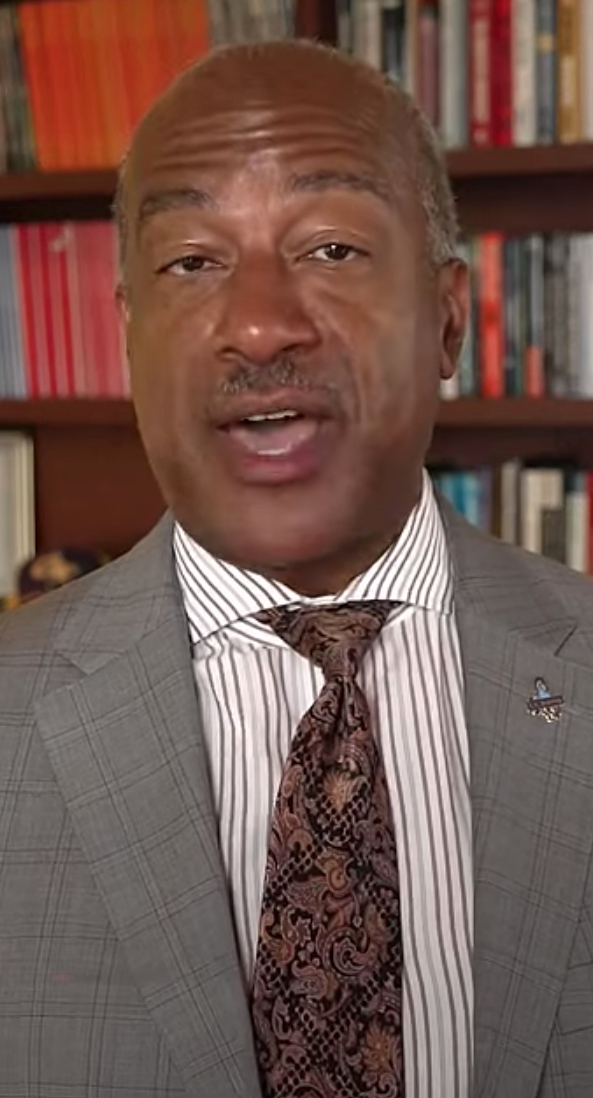
It's a celebration of (1) the accomplishments of the faculty entering a new chapter in their lives (2) the extraordinary retirement years of the late Robbin Thorp of the Department of Entomology and Nematology; and a congratulatory message by Chancellor Gary May.
The video is online at
https://youtu.be/s6fxdg2XZPA?si=u0SG1UvUG34zQxmV.
"Summer is nearly over, and the fall quarter begins soon," said Leal, professor of biochemistry in the Department of Molecular and Cellular Biology and former professor and chair of the Department of Entomology (now the Department of Entomology and Nematology). "Let's pause and express our gratitude to our colleagues who transitioned to emeriti status this summer."
"For decades, they strived to make UC Davis a better place, and many will remain engaged with research, teaching, and public service," he noted.
Leal said the late Distinguished Emeritus Professor Robbin Thorp (1933-2019) epitomizes how emeriti contribute to UC Davis. Thorp, a 30-year member of the entomology faculty, and a tireless advocate of pollinator species protection and conservation, retired in 1994, but he continued working until several weeks before his death on June 7, 2019, at age 85. In 2014, he co-authored two books: Bumble Bees of North America: An Identification Guide (Princeton University,) and California Bees and Blooms: A Guide for Gardeners and Naturalists (Heyday). He published more than 50 percent of his papers following his retirement.
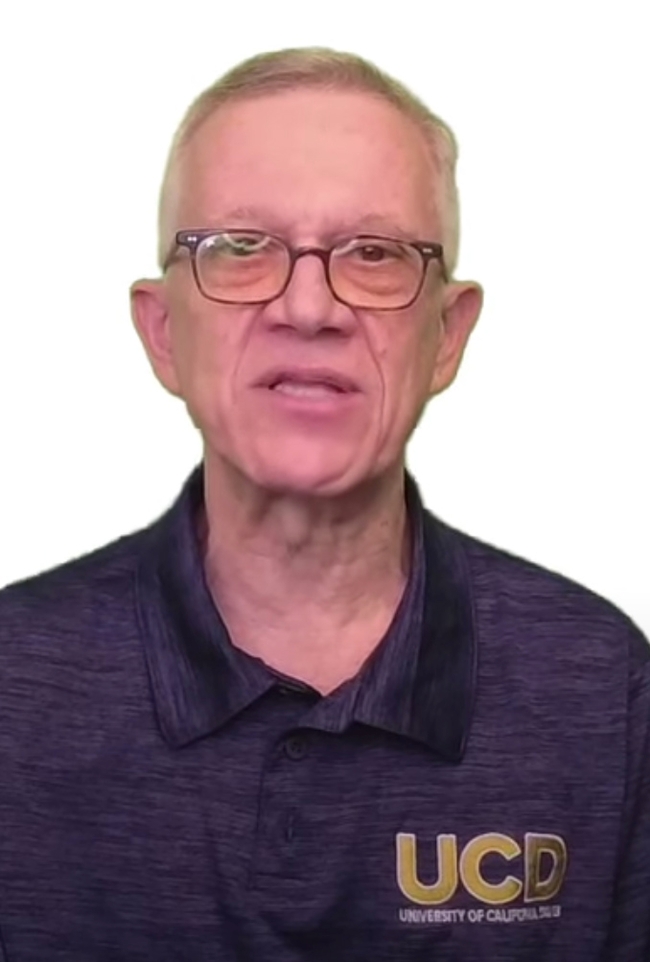
- UC Davis offered COVID tests within three weeks of our nation's first known patient with community-acquired COVID-19.
- Their research led to the development of better ceramic and glass materials;
- They helped improve military retention;
- They developed innovative techniques for shoulder and wrist reconstruction;
- They generated one of the world's largest and longest-running systems for monitoring butterfly faunas;
- They led plans for the UC Davis National Cancer Institute to be designated a Comprehensive Cancer Center;
- They are film historians who authored books such as Paris in the Dark: Going to the Movies in the City of Light, 1930-1950;
- They helped create the world's first total-body PET scanner;
- They brought a global perspective to the table to create innovative and pragmatic approaches to sustainability;
- Their research showed how music and dance articulate ethnic, gender, regional, and national identities;
- They helped us, and more importantly, lawmakers, understand how the toxic action of pesticides may affect aquatic systems and organisms;
- Their research shed light on the psychological development of young children;
- They unraveled molecular processes leading to arthritis;
- They showed how management controls facilitate strategic alliances and supply chain partnerships;
- They integrated methods from traditional engineering, operation research, and economics to solve water and environmental management problems;
- They provided comprehensive psychiatric services to ethnic and sexual minorities, including refugees and immigrants;
- They colleagues created new approaches for using plants for the production of recombinant proteins with various applications, including medicine;
- They elucidated how natural products influence the function of ion channels in the nervous system;
- They provided emergency medical care and taught nursing, air medical, EMS, and disaster medicine courses;
- They designed programs for teachers to investigate their teaching skills and students' learning;
- They investigated how plants edit and repair DNA;
- They advanced our understanding of infectious diseases and aging in nonhuman primates; and
- Their research led to improvements in bean cultivars in California, the United States, Latin America and Africa;
The video tribute includes images of many of the emeriti, meant as a small representation of the achievements of all.
In his message, Chancellor May told the new emeriti: "You played a central role in keeping UC Davis at the forefront of excellence. Your continued engagement through teaching, research, volunteering and philanthropy is vital to our continued growth and success. So I encourage you to stay engaged with campus. The UC Davis Emeriti Association is here with resources and support for this newest chapter of your career. Please take advantage of it. Thank you for our dedication to UC Davis and congratulations on reaching this milestone."
Among its many activities, UC Davis Emeriti Association (UCDEA) interviews and records emeriti who have made "significant contributions to the development of the university." See Video Records Project.
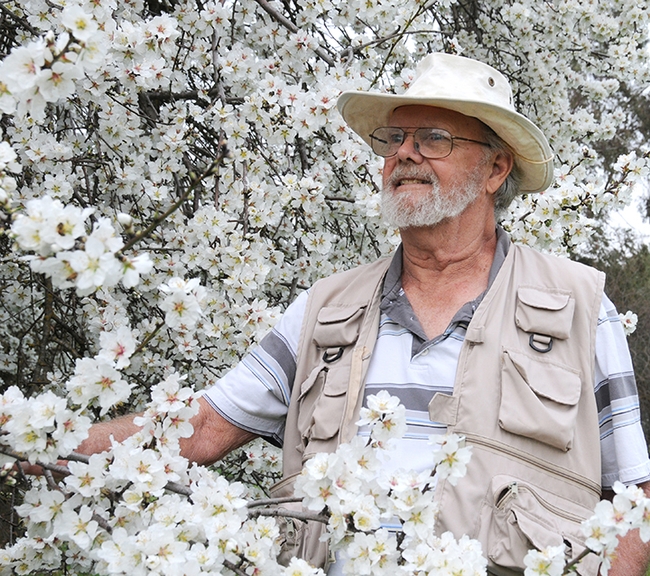
- Author: Kathy Keatley Garvey

"Walsh is known internationally for his research on the modes of action and resistance mechanisms of acaricides on spider mites and regionally in the Pacific Northwest for his extension and outreach efforts on specialty crops," ESA announced in a news release, citing that:
"Walsh has maintained a well-funded (more than $30 million) and productive program as the research director of the Environmental and Agricultural Entomology Laboratory located at the WSU Irrigated Agriculture Research and Extension Center in the Yakima Valley near Prosser, Washington. Walsh is the Extension integrated pest management (IPM) coordinator for Washington State and the Washington State liaison representative to the U.S. Department of Agriculture IR-4 Project."
"Walsh has an extensive and varied integrated pest and pollinator management research and Extension program assisting regionally important commodities including hops, alfalfa, grapes, and mint. Walsh also directs environmental impact studies on alfalfa leafcutting and alkali bees, the key pollinators of alfalfa produced for seed. Walsh's efforts in IPM have resulted in the documented reduction of over 100,000 pounds of insecticide use in the Pacific Northwest annually."
Born in New York in 1963 and a resident of California since 1969, Walsh holds a bachelor's degree in biology from UC Santa Cruz (1985). He received his doctorate in entomology from UC Davis in 1998, studying with major professor Frank Zalom, who went on to become a UC Davis distinguished professor and president and Honorary Member of ESA. "He is very deserving," Zalom said. "I couldn't be more proud of all that he has accomplished."
Said Walsh: "I was Frank's first PhD student. Frank had one before me, Rachid Hanna. Frank picked up Rachid when Rachid was orphaned when his original professor left UC Davis. Rachid and I quibble about who was Frank's first student. I'm the first that went from start to finish with Frank."
"(Professors) Sean Duffy and Harry Kaya were also on my PhD committee," Walsh said.
Kaya remembers Walsh well. "He was studying integrated pest management at UC Davis and was an outstanding graduate student in Frank Zalom's lab," Kaya said. "Even as a graduate student, he published some significant papers on IPM research, and I had no doubt that he would excel in research in his post graduate years. He has not only done superb IPM research but has been a leader in the Entomological Society of America as well as other national and international organizations. He richly deserves being elected as an ESA Fellow."
Walsh, Zalom and Dean Helene Dillard of the UC Davis College of Agricultural and Environmental Sciences, then Extension director at Cornell, spent three weeks together on a USDA-sponsored agricultural extension tour of China.
Walsh joined the WSU Department of Entomology as assistant professor in 1998 and advanced to associate professor in 2003 and to professor in 2007. The author of more than 200 publications, he annually delivers more than 35 Extension presentations. He has mentored 12 doctoral students and 11 master's degree students.
Walsh served as president of the Pacific Branch of ESA (PBESA) in 2010 and represented PBESA on the ESA governing board from 2013 through 2019. Among his ESA awards: Excellence in IPM Award and he led two teams that received the IPM Team Award.
Walsh's WSU awards include the Sahlin Award for Outreach and Engagement, the Excellence in Extension Award, the Team Interdisciplinary Award, and the Excellence in Integrated Research and Extension Award.
For his work in the hops industry, the International Hop Growers Bureau knighted him into of the Order of the Hop (Chevalier) in 2017.
A WSU news story (Sept. 7, 2023) related that Walsh has "worked primarily on pest control issues, mostly on hops, grape vines, mint, and alfalfa. One of his first successes at WSU in 2005 involved developing a novel method for controlling cutworms, which climb up from the soil in spring to nibble on grapevine buds."
Walsh initially set out to become a botanist. “I was working in a local Extension office in California after I got my bachelor's degree," he told the WSU writer Scott Weybright. "That work involved battling spider mites on strawberries. I kind of fell into entomology, but I love the work and the creative solutions we find to help growers."
Another reason he wanted to become an entomologist: job security. He told Weybright that there are five-to-ten entomology jobs for every botany job. “We as humans are very efficient at moving pests around,” Walsh added. “There is always going to be a new pest and a need for someone to figure out how to best fight it.”
His wife, Catherine (Kikie) is a senior software engineer with Altera Digital, a hospital software firm. The couple, married 35 years, raised three children, Claire, Russ, and Jeff, all WSU grads. Claire is the lifecycle marketing manager with Niantic Labs; Russ is working toward his master's degree in teaching at WSU Tri-Cities: and Jeff is a site reliability engineer at TikTok.
Others named 2023 ESA Fellows are:
- Cassandra Extavour, Harvard University
- James Hagler, U.S. Department of Agriculture-Agricultural Research Service
- Alvin M. Simmons, U.S. Department of Agriculture-Agricultural Research Service
- Lukasz Stelinski, University of Florida
- Edward L. Vargo, Texas A&M University
The six will be honored during Entomology 2023: Insects and Influence: Advancing Entomology's Impact on People and Policy, set Nov. 5-8, in National Harbor, Md.
ESA, founded in 1889, is a worldwide organization of more than 7000 members, who are affiliated with educational institutions, health agencies, private industry, and government. Members are researchers, teachers, extension service personnel, administrators, marketing representatives, research technicians, consultants, students, pest management professionals, and hobbyists.
Resources:
- A Career Battling Pests Leads to National Honor for Scientist (Sept. 7, 2023, Washington State University)
- WSU Showcase Award, YouTube, 2017
- ESA's 2023 Fellow Awards, Entomological Society of America.
